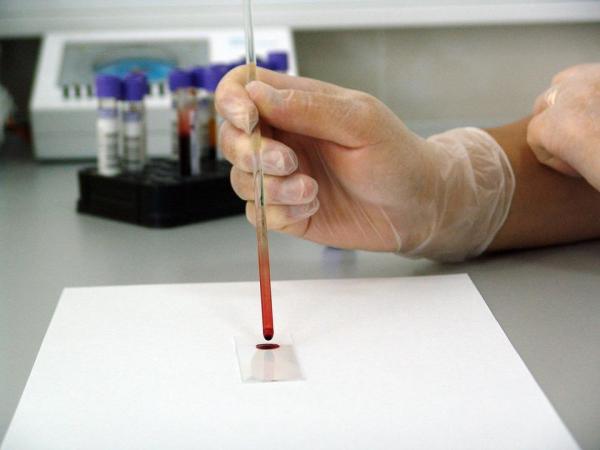
Blood tests are very necessary tests carried out, specifically a dog falls ill or is growing old. These tests are very common as they allow people to obtain a lot of information in a short time and in a relatively inexpensive way.
In this AnimalWised article we will cover the most important parameters that are valued in a blood test, as well as look at diseases which can alter these results.We will be answering your question of how to understand a dog’s blood test.
Importance of a complete blood analysis for dogs
The extraction of blood for analysis is a very common and important technique practiced in all veterinary clinics. Blood samples are most commonly extracted from the front leg, but in some cases, blood can be drawn from the hind legs or neck.
Many clinics already have their own necessary equipment to analyze blood, thus being able to obtain results in a matter of minutes. This allows for a quicker start to treatment, if necessary.
If, in some cases, more information is requires or if there is further need to assess specific parameters, a veterinarian will send the sample to an external laboratory. In addition, you can also buy kits that allow you to detect the presence of diseases such as canine parvovirus. This type of blood test is normally performed before an operation, in case there are any additional risks which need to be taken into account, specifically in relation to anesthesia.
In a blood test in dogs, what are the normal values?
When assessing these results, the reference values offered by the laboratory must be taken into account. The reason for this is that they may come in variations. In the next section we will elaborate more on how to analyse a dog’s blood test.

Blood test in dogs: blood count
If you assess the analysis you will note that the it is divided into four different sections. The first is the blood count. In this section you will see an analysis of red and white blood cells and the platelets:
- Red blood cells or erythrocytes are responsible for transporting oxygen through the blood. Its lack can result in anemia in dogs, which can be regenerative or non-regenerative. In non-regenerative anemia, bone marrow produces reticulocytes (immature red blood cells) as a way of trying to compensate for the deficiency. This type of anemia will have a better prognosis than a regenerative one, where lack occurs as a result of zero production. The amount of these globules is measured rapidly in the hematocrit and, the lower it is, the higher the risk.
- White blood cells or leukocytes are related to the body's defense against diseases. An elevation of its values indicate that the dog could be suffering from an infection. On the other hand, if their values are too low, the animal could be immunosuppressed.
- A hemogram also includes the platelet count which, if presented as a low number, could mean coagulation problems and hemorrhages. On the other hand, a high number could indicate the appearance of thrombi.
Blood test in dogs; white blood cells
There are different types of leukocytes in the blood. The following stand out:
- Neutrophils: are those that act in the first line of defense of the organism. They tend to shoot at bacterial infections. If the pathogen is a virus, you will notice that the number will in fact decrease.
- Eosinophils: their numbers increase in cases of allergies or parasitic infestations.
- Lymphocytes: there are several types of lymphocytes, including B lymphocytes or T lymphocytes. They may sometimes appear in high numbers, as in cases of leukemia. It is however more common for their values to decrease in the initial phases of viral diseases.
Blood analysis in dogs: biochemistry
This section of analytics includes the count of various substances such as glucose, urea and proteins. To explain how to interpret of a dog’s blood test, we must look at the most important biochemical parameters. These parameters provide us with information about the functioning of different organs:
- Proteins: the ratio of proteins in blood is very important for this interpretation. In this count, immunoglobulins and albumin are measured. Elevated proteins can mean your animal may be suffering from dehydration. Its decrease, however, is indicative of different conditions that can be diagnosed by taking into account the specific clinical case and its total count.
- Glucose: is the sugar which circulates in the blood. High glucose values can indicate that the dog is suffering from diabetes. Glucose can also increase as a result of stress, however, this is more common in cats. A decrease in this element can mean the animal is suffering from physical weakness, seizures or insulinoma.
- Creatinine: high values of creatinine in the blood can be related to both acute or chronic renal failure.
- Urea: is a waste product which comes from a decomposition of proteins and is eliminated through the kidneys. If your dog present a high Urea count, it could mean he/she is suffering from renal alterations.
- ALT and AST: a transaminase count presents us with information about liver functioning. If elevated, it can indicate that a liver problem is present.
- Bilirubin: is another parameter related to the liver. It is a waste product which results from a breakdown of red blood cells. This may be due to a hemolytic anemia, an immune system disease in which red blood cells are destroyed at a faster rate than normal.

Clinical analyzes and their interpretation
Despite all the information provided by a count, to know how to interpret a blood test in dogs, we must also look at the specific clinical case as an entirety. We need to be aware of the symptomatology with which the animal presents. In addition, the alteration of a single parameter does not always mean a pathology is present.
An analysis, therefore, should be interpreted as a whole. This is done by taking into account particular conditions of a dog, such age or medical history. Our above explanation also only includes basic parameters. A veterinarian, however, can reach a more precise diagnosis. A vet can ask the laboratory for an analysis of elements such as calcium, which can appear elevated due to the presence of:
- tumors
- phosphorus
- renal failure
- fructosamine ( to determine any presence of hyperglycemia (diabetes) )
- thyroid hormones ( which will inform us of whether or not there is hypo or hyperthyroidism)
Observing blood under a microscope can also provide interesting or necessary information. A microscopic analysis allows for the interpretation of size, shape and/or number of cells. An amount in which normal values may appear elevated or decreased will informs us about the severity of damage. A vet will be the only person able to arrive at a diagnosis and prescribe appropriate treatment. Once this is established, another blood test will be scheduled as a follow up to reassess the blood count.

If you want to read similar articles to How To Understand A Dog’s Blood Test, we recommend you visit our Basic care category.